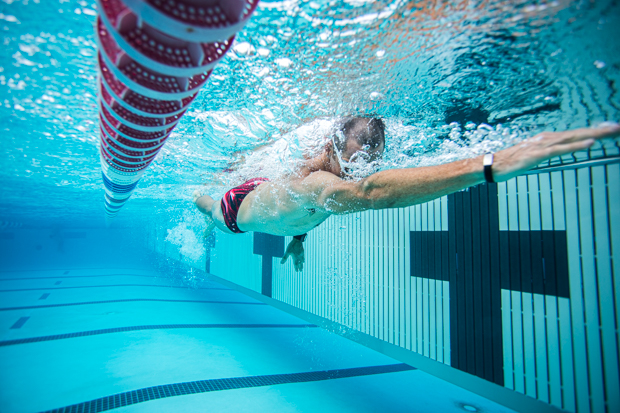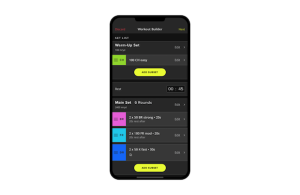
Powerboat designers create hulls that allow the boat to plane in the water. Lift is the force responsible for this. Swimmers will never exhibit lift in the way powerboats do, but lift is still a component of freestyle. Lift is worth discussing once you’ve mastered everything else and this is what remains.
This is an advanced concept, and you won’t find too many discussions on the topic of lift in swimming. But we’re nearing the end of the Guppy Challenge and I thought the time is right.
When my swimming is going really well – a rare moment in time when I’m at my fittest – lift becomes a noticeable component of my extend phase (or glide, or whatever you want to call that part of the swim stroke immediately after the catch). My hand for sure, and to a degree my whole arm, is better able to remain parallel to the surface of the water and not far below it. My minor shoulder muscles have finally adapted to a high elbow posture during the pull. Only when I’m really ready to swim my most efficient freestyle am I in a position to generate, or participate in, lift during this phase.
That said, when I see lift written about it’s upon commencement of the pull phase. I emailed Gary Hall, Sr., about this. He’s the first on a very short list who I felt I could discuss this with who I’m confident knows what he’s talking about.
I asked him if, indeed, lift occurs during the extend phase of freestyle, or am I hallucinating? Again? “Is my body a fabulist,” I asked Gary, “telling me a story about lift that in fact isn’t true. Is there no lift occurring during this extend phase of freestyle?”
Gary replied by writing, “When the arm and hand are stretched out in front of the swimmer, and before any downward force is applied, they act like a wing. The lift generated by the Bernoulli effect is determined by the speed and shape of the moving arm/hand and body. For guys like Sun Yang with long levers, a 60 stroke rate, holding for about a second in front on each stroke, there is probably some significant Bernoulli effect of lift. It is not a coincidence that swimmers deliver their strong surge kick and often reach their highest velocity in the cycle right after the arm enters the water, causing more lift. The lift from the Bernoulli effect would be most pronounced in the hip driven or hybrid freestyle technique, not the shoulder driven technique.”

Gary replied by writing, “When the arm and hand are stretched out in front of the swimmer, and before any downward force is applied, they act like a wing. The lift generated by the Bernoulli effect is determined by the speed and shape of the moving arm/hand and body. For guys like Sun Yang with long levers, a 60 stroke rate, holding for about a second in front on each stroke, there is probably some significant Bernoulli effect of lift. It is not a coinci
There’s some controversy around the Bernoulli Effect in swimming. The revered swim coach Ernie Maglischo wrote in his 1982 book about the Bernoulli Effect, but in the context of the pull phase. Maglischo reportedly wrote in a subsequent edition that he was wrong about that. It’s strict Newtonian physics during the pull. Forget S patterns and pressure differentials. Grip and rip it, in other words.
This is consistent with what Gary wrote me above. He continued on: “However, I still believe that most of the lift from the front end of the swimmer is derived after the catch, from the swimmer pressing down at the beginning of the pulling motion…the Newtonian lift, not from the ‘wing’. The arm and hand are not really a great wing.”
If I understand Gary right, he’s limiting his Bernoulli Effect comments to the extend phase. After that, Newtonian. The change of motion of an object is proportional to the force impressed; and is made in the direction of the straight line in which the force is impressed. Newton’s Second Law of Motion.
Back to the extend phase, though. I’m not actively attempting to gain lift here. It’s not like my hand is an aileron. The posture of my hand in the water is subtle and the Bernoulli Effect isn’t about water hitting your louvre-like angled-up hand; it’s about the difference in pressure between the water above and below your hand. This whole thing is subtle and when I look at really good high elbow anchor specialists – when I look at a Grant Hackett video – it’s hard to see an attempt at lift during the extend phase. But I think it’s there. In fact, I think some subtle lift is what helps good swimmers keep their hands close to the surface during the extend phase.
Once the swimmer has exhausted the benefit of his or her arm extension and must commence the pull, this is where, according to Gary in the quote above, “most of the lift” occurs. But in this case, it’s not just “lift” that helps keep the arm and hand near the surface after the catch, but “lift” as a force that very slightly raises the “hull” of the body out of the water. Lift takes place because the very first action after the extend phase is a downward press on the water.
This would be the case regardless, because the hand and forearm must get from parallel to perpendicular in the water. The hand travels, like a spear, through the water, but then must translate to become a canoe paddle in the water. That moment of translation requires the hand to press down on the water, which means lift.
Here’s when you get zero lift: If your hand drifts down during the extend phase. In this case, you’re not getting lift during the extend phase, and you won’t get the benefit of lift from that press-down motion during that translation of the arm from spear to paddle. That drift-down is the rule, not the exception. This describes most swimmers… and me too, unless it’s one of those rare moments when I’m really swim fit and I’m paying attention to my technique.
Finally, did you notice that FORM Goggles now has a workout builder? This is a big deal and flips the switch, for me. I love the goggle; the instant feedback; real-time, all-the-time, clock knowledge; but I also love writing my own workouts.
The Guppy Challenge Series, in partnership with FORM goggles, thus far:
Guppy Challenge Week 1; Workouts for Week 1
Guppy Challenge Week 2; Workouts for Week 2
Guppy Challenge Week 3; Workouts for Week 3
The High Elbows of Good Swimmers; Workouts for Week 4
Swim Paraphernalia for Guppies; Workouts for Week 5
Swimming Isn’t Intuitive; Workouts for Week 6
Debunked Swim Mythology; Workouts for Week 7
Every Swim Workout is a Race... Not! Workouts for Week 8
Visualization, Relaxation, Emulation; Workouts for Week 9
What is Body Rotation in Freestyle? Workouts for Week 10
Lift as a Relevant Force in Swimming. Workouts for Week 11



